基于 DMS Dify+Notebook+Airflow 实现 Agent 的一站式开发
本文作者:阿里云数据库开发专家 陈枢华
背景与挑战
Dify 作为一款低代码 AI 应用开发平台,凭借其直观的可视化工作流编排能力,极大降低了大模型应用的开发门槛。然而,在实际企业级落地过程中,我们发现其原生能力仍存在两个关键瓶颈:
• 代码执行能力受限:Dify 内置的 Sandbox 节点虽支持基础 Python 代码执行,但无法安装自定义 Python 包,难以支撑复杂的业务逻辑、数据处理或算法调用;
• 缺乏自动化调度机制:Dify 原生架构不支持 Agent 或 Agentic Workflow 的定时触发、周期性运行与依赖编排,导致其难以融入企业级自动化运维体系。
这两个问题严重制约了 Dify 在生产环境中的深度应用——尤其当我们希望构建一个具备“感知-决策-执行-反馈”闭环能力的智能 Agent 时,仅靠 Dify 自身往往力不从心。
为突破这些限制,我们在实践中探索出一套 “Dify + DMS Notebook + DMS Airflow”三位一体的一站式增强开发架构,有效补齐了 Dify 在执行能力与调度能力上的短板:
• ✅ DMS Notebook:提供完整、可定制的 Python 运行环境,支持第三方库安装、交互式开发与复杂逻辑实现,作为 Dify Sandbox 的强力补充;
• ✅ DMS Airflow:作为统一调度引擎,实现对 Dify 工作流、Notebook 脚本或 Agent 任务的定时触发、依赖管理与可靠执行;
• ✅ DMS 平台集成:实现从开发、调试、部署到调度、监控的全链路闭环管理,显著提升 Dify 在企业场景下的工程化落地能力。
本文将以一个销售数据分析机器人的完整开发案例,详细介绍如何基于 DMS 平台,构建一个可调度、可扩展、可运维的 Agent 系统。
使用 DMS Notebook 扩展 Dify 的代码执行能力
为什么需要 Notebook?
在 Dify 中,若需调用 Pandas 进行数据清洗、使用 Prophet 做时间序列预测,或集成企业内部 SDK,Sandbox 节点往往无能为力。而 DMS Notebook 提供了完整的 Python 环境,支持:
• 自定义 pip 包安装;
• 环境变量配置(如 AK/SK、API Key);
• 异步服务开发(如 FastAPI);
• 与 VPC 内其他服务安全互通。
这使其成为 Dify 外部能力扩展的理想“执行单元”。
步骤详解:构建一个销售数据分析 API 服务
1.创建 DMS Notebook 会话
• 进入 DMS 控制台 > Notebook 会话 > 创建会话;

• 各参数的定义如下:

• 选择合适的 Python 镜像版本;

• 在 配置 > 编辑设置 中:
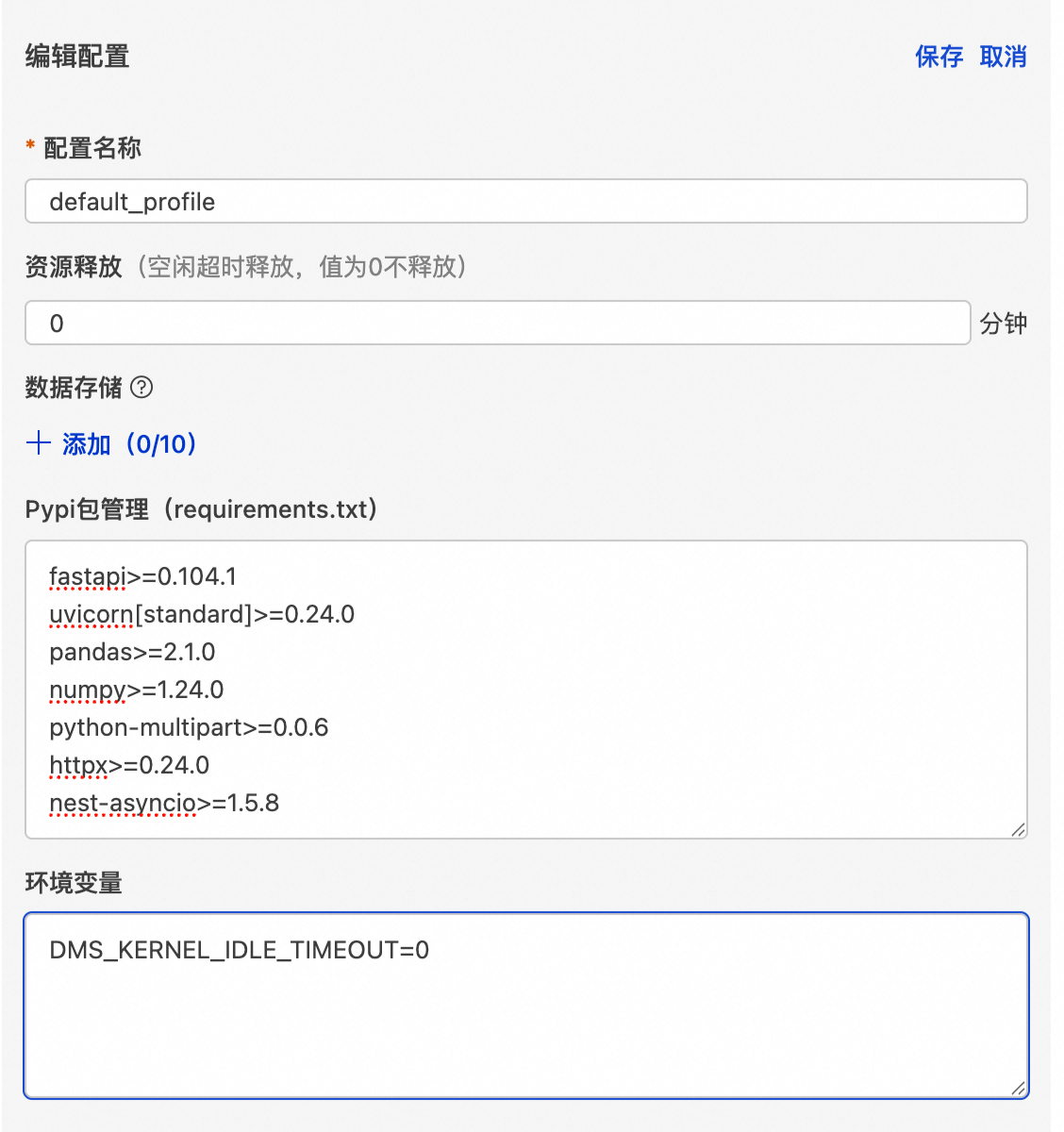
• PyPI 包管理:按 requirements.txt 格式填入依赖(如 pandas, fastapi, uvicorn, nest-asyncio);
• 环境变量:设置 ALIBABA_CLOUD_ACCESS_KEY_ID、ALIBABA_CLOUD_ACCESS_KEY_SECRET、大模型 API Key 等;
• 关键配置:
• fastapi、uvicorn、nest-asyncio库是必须要安装的;
• 设置 资源释放时间 = 0(防止服务被自动释放);
• 设置环境变量 DMS_KERNEL_IDLE_TIMEOUT=0(避免 Jupyter Kernel 因空闲被 kill)。
💡 踩坑提示:若未设置 DMS_KERNEL_IDLE_TIMEOUT=0,长时间运行的 API 服务可能在空闲数分钟后被系统回收,导致后续调用失败。
• 创建完成后,在notebook会话窗口中点击启动即可

2.编写并启动 FastAPI 服务
• 点击文件夹图标,右键点击default(默认库),再点击新建Notebook文件

• 在代码块中编写相关的python代码,可以参考以下模板构建你的API服务,更多FastAPI相关的使用方法请查看官方文档https://fastapi.tiangolo.com/
点击查看代码
import os
from fastapi import FastAPI, HTTPException, Request, File, UploadFile, Path, Query, Form, Header
from fastapi.staticfiles import StaticFiles
from typing import Optional
import nest_asyncio
import asyncio
import httpx
import io
'''
注意,Jupyter本身就在一个asyncio事件循环中运行。我们不能在已有循环中直接运行另一个循环,但nest_asyncio这个库可以“打补丁”,允许我们这样做。
'''
nest_asyncio.apply()
app = FastAPI(title="Your Service Name", description="Description of Your Service")
# 创建static目录(如果不存在)
static_dir = "static"
if not os.path.exists(static_dir):
os.makedirs(static_dir)
# 挂载静态文件服务
app.mount("/static", StaticFiles(directory=static_dir), name="static")
@app.get("/")
async def root():
"""
根节点,返回服务基本信息
# --- 如何使用 curl 调用 ---
curl -X GET "http://127.0.0.1:8000/"
"""
return {
"message": "Service is running",
"documentation": "/docs",
"note": "..."
}
@app.post("/process-data/{item_id}")
async def process_data(
request: Request, # 使用 Request 对象来接收原始请求
# 路径参数
item_id: int = Path(..., title="物品ID", ge=1),
# 查询参数
is_premium: bool = Query(False, description="是否为高级物品"),
# 请求头参数
x_token: Optional[str] = Header(None, description="自定义的认证Token")
):
"""
接收 JSON 请求体、路径参数、查询参数和请求头。
# --- 如何使用 curl 调用 ---
# -X POST: 指定请求方法
# URL: 包含路径参数 {item_id} 和查询参数 ?is_premium=true
# -H: 添加请求头 (Header)
# -d: 发送请求体 (Body),这里是 JSON 字符串
curl -X POST "http://127.0.0.1:8000/process-data/101?is_premium=true" \
-H "Content-Type: application/json" \
-H "X-Token: my-secret-token" \
-d '{"name": "笔记本电脑", "price": 7999.9, "tags": ["electronics", "office"]}'
"""
if x_token != "my-secret-token":
raise HTTPException(status_code=401, detail="X-Token 无效")
try:
# 手动解析 JSON 请求体
json_body = await request.json()
name = json_body.get("name")
price = json_body.get("price")
# 你的业务逻辑代码
if not name or not price:
raise HTTPException(status_code=400, detail="请求体中缺少 'name' 或 'price'")
return {
"message": "数据处理成功",
"received_data": {
"item_id": item_id,
"is_premium": is_premium,
"x_token": x_token,
"body": json_body
}
}
except Exception as e:
raise HTTPException(status_code=500, detail=f"服务执行错误: {str(e)}")
@app.post("/upload-file")
async def upload_file(
# 表单数据
token: str = Form(...),
# 上传文件
file: UploadFile = File(...)
):
"""
通过表单(form-data)上传文件和附带的文本信息。
# --- 如何使用 curl 调用 ---
# -F: 用于发送 multipart/form-data
# -F "file=@/path/to/your/file.txt": @符号表示后面是文件路径,curl会读取该文件内容作为上传数据
# -F "token=user123": 发送一个名为 token 的表单字段
# 注意: 请将 /path/to/your/file.txt 替换为你的本地文件真实路径
curl -X POST "http://127.0.0.1:8000/upload-file" \
-F "file=@./test_upload.txt" \
-F "token=my-form-token"
"""
# 为了让curl示例能工作,我们先创建一个示例文件
if not os.path.exists("test_upload.txt"):
with open("test_upload.txt", "w") as f:
f.write("This is a test file for curl upload.")
try:
contents = await file.read()
file_location = os.path.join(static_dir, file.filename)
with open(file_location, "wb") as f:
f.write(contents)
return {
"message": "文件上传成功!",
"token": token,
"filename": file.filename,
"file_size": len(contents),
"file_url": f"/static/{file.filename}"
}
except Exception as e:
raise HTTPException(status_code=500, detail=f"文件处理错误: {str(e)}")
@app.get("/status")
async def get_server_status():
"""
获取服务器状态。
# --- 如何使用 curl 调用 ---
curl -X GET "http://127.0.0.1:8000/status"
"""
return {"status": "running"}
async def run_server(host="127.0.0.1", port=8000):
"""在后台运行uvicorn服务器"""
import uvicorn
config = uvicorn.Config(app, host=host, port=port, log_level="info")
server = uvicorn.Server(config)
# uvicorn.run() 是一个阻塞调用,所以我们用更底层的Server.serve()
await server.serve()
task = asyncio.create_task(run_server(host="0.0.0.0", port=8000))
# 等待服务启动
await asyncio.sleep(2)
# 创建一个异步HTTP客户端
async with httpx.AsyncClient() as client:
print("正在向 http://127.0.0.1:8000/status/ 发送请求...")
# 发送POST请求
response = await client.get("http://127.0.0.1:8000/status")
# 打印结果
if response.status_code == 200:
print("服务启动成功")
else:
print("服务启动失败,请检查报错信息")
• 接下来我们以构建一个单日销售数据分析的API为例,代码内容如下:
点击查看代码
import os
import pandas as pd
from fastapi import FastAPI, HTTPException, Request, File, UploadFile
from fastapi.staticfiles import StaticFiles
import nest_asyncio
import asyncio
import httpx
import io
'''
注意,Jupyter本身就在一个asyncio事件循环中运行。我们不能在已有循环中直接运行另一个循环,但nest_asyncio这个库可以“打补丁”,允许我们这样做。
'''
nest_asyncio.apply()
app = FastAPI(title="Sales Data Analysis Service", description="Provides data analysis and chart generation capabilities for Dify")
# 创建static目录(如果不存在)
static_dir = "static"
if not os.path.exists(static_dir):
os.makedirs(static_dir)
# 挂载静态文件服务
app.mount("/static", StaticFiles(directory=static_dir), name="static")
def load_sales_data_from_file(file_content: bytes):
"""从上传的文件内容加载销售数据"""
try:
# 将字节内容转换为StringIO对象
csv_string = file_content.decode('utf-8')
df = pd.read_csv(io.StringIO(csv_string))
# 验证必要的列是否存在
required_columns = ['Date', 'Product', 'Price', 'Amount', 'Region']
if not all(col in df.columns for col in required_columns):
raise ValueError(f"CSV file must contain columns: {', '.join(required_columns)}")
# 转换数据类型
df['Date'] = pd.to_datetime(df['Date'])
df['Price'] = pd.to_numeric(df['Price'], errors='coerce')
df['Amount'] = pd.to_numeric(df['Amount'], errors='coerce')
# 计算销售额 (Sales = Price × Amount)
df['Sales'] = df['Price'] * df['Amount']
return df
except Exception as e:
raise HTTPException(status_code=500, detail=f"Error processing CSV file: {str(e)}")
@app.get("/")
async def root():
"""Root endpoint, returns service information"""
return {
"message": "Sales Data Analysis Service is running",
"documentation": "/docs",
"endpoints": [
"POST /analysis/daily_sale_analysis"
],
"note": "Require a CSV file upload with columns: Date, Product, Price, Amount, Region"
}
@app.post("/analysis/daily_sale_analysis")
async def daily_sale_analysis(
file: UploadFile = File(...)
):
"""当日销售数据分析 - 分析上传文件中的销售数据"""
try:
# 验证文件类型
if not file.filename.endswith('.csv'):
raise HTTPException(status_code=400, detail="文件必须是CSV格式")
# 读取上传的文件
file_content = await file.read()
df = load_sales_data_from_file(file_content)
# 获取数据中的日期范围
df['Date'] = pd.to_datetime(df['Date']).dt.date
unique_dates = sorted(df['Date'].unique())
if len(unique_dates) == 0:
raise HTTPException(status_code=400, detail="数据文件中没有有效的日期数据")
# 如果有多个日期,取最新的日期作为分析目标
target_date = unique_dates[-1] if len(unique_dates) > 1 else unique_dates[0]
# 筛选目标日期的数据
daily_data = df[df['Date'] == target_date].copy()
if daily_data.empty:
raise HTTPException(status_code=400, detail=f"没有找到日期 {target_date} 的销售数据")
# 基础统计
total_sales = daily_data['Sales'].sum()
total_orders = len(daily_data)
total_quantity = daily_data['Amount'].sum()
avg_order_value = total_sales / total_orders if total_orders > 0 else 0
# 产品分析
product_analysis = daily_data.groupby('Product').agg({
'Sales': 'sum',
'Amount': 'sum',
'Price': 'mean'
}).round(2)
# 按销售额排序,取前5名产品
top_products = product_analysis.sort_values('Sales', ascending=False).head(5)
top_products_list = []
for product, row in top_products.iterrows():
top_products_list.append({
"product": product,
"sales": float(row['Sales']),
"quantity": int(row['Amount']),
"avg_price": float(row['Price'])
})
# 地区分析
region_analysis = daily_data.groupby('Region').agg({
'Sales': 'sum',
'Amount': 'sum'
}).round(2)
# 按销售额排序
top_regions = region_analysis.sort_values('Sales', ascending=False)
region_list = []
for region, row in top_regions.iterrows():
region_list.append({
"region": region,
"sales": float(row['Sales']),
"quantity": int(row['Amount']),
"percentage": round(float(row['Sales']) / total_sales * 100, 2)
})
# 价格区间分析
daily_data['price_range'] = pd.cut(daily_data['Price'],
bins=[0, 100, 500, 1000, 5000, float('inf')],
labels=['0-100', '100-500', '500-1000', '1000-5000', '5000+'])
price_range_analysis = daily_data.groupby('price_range').agg({
'Sales': 'sum',
'Amount': 'sum'
}).round(2)
price_ranges = []
for price_range, row in price_range_analysis.iterrows():
if not pd.isna(row['Sales']) and row['Sales'] > 0:
price_ranges.append({
"range": str(price_range),
"sales": float(row['Sales']),
"quantity": int(row['Amount'])
})
# 生成洞察分析
insights = []
# 销售额洞察
if total_sales > 100000:
insights.append(f"当日销售表现优秀,总销售额达到 {total_sales:,.2f} 元")
elif total_sales > 50000:
insights.append(f"当日销售表现良好,总销售额为 {total_sales:,.2f} 元")
else:
insights.append(f"当日销售额为 {total_sales:,.2f} 元,可能需要关注销售策略")
# 产品洞察
if len(top_products_list) > 0:
best_product = top_products_list[0]
insights.append(f"最佳销售产品是 {best_product['product']},销售额 {best_product['sales']:,.2f} 元")
# 地区洞察
if len(region_list) > 0:
best_region = region_list[0]
insights.append(f"销售表现最佳的地区是 {best_region['region']},占总销售额的 {best_region['percentage']}%")
# 订单洞察
if avg_order_value > 1000:
insights.append(f"平均订单价值较高,为 {avg_order_value:,.2f} 元,显示客户购买力强")
return {
"analysis_date": str(target_date),
"summary": {
"total_sales": round(float(total_sales), 2),
"total_orders": int(total_orders),
"total_quantity": int(total_quantity),
"average_order_value": round(float(avg_order_value), 2)
},
"top_products": top_products_list,
"region_analysis": region_list,
"price_range_analysis": price_ranges,
"insights": insights,
"data_info": {
"date_range": f"{unique_dates[0]} 到 {unique_dates[-1]}" if len(unique_dates) > 1 else str(unique_dates[0]),
"total_records": len(daily_data),
"unique_products": len(daily_data['Product'].unique()),
"unique_regions": len(daily_data['Region'].unique())
}
}
except HTTPException:
raise
except Exception as e:
raise HTTPException(status_code=500, detail=f"当日销售数据分析错误: {str(e)}")
@app.get("/status")
async def get_server_status():
"""获取服务器状态"""
try:
return {
"status": "running"
}
except Exception as e:
raise HTTPException(status_code=500, detail=f"Error getting server status: {str(e)}")
async def run_server(host="127.0.0.1", port=8000):
"""在后台运行uvicorn服务器"""
import uvicorn
config = uvicorn.Config(app, host=host, port=port, log_level="info")
server = uvicorn.Server(config)
# uvicorn.run() 是一个阻塞调用,所以我们用更底层的Server.serve()
await server.serve()
task = asyncio.create_task(run_server(host="0.0.0.0", port=8000))
# 等待服务启动
await asyncio.sleep(2)
# 创建一个异步HTTP客户端
async with httpx.AsyncClient() as client:
print("正在向 http://127.0.0.1:8000/status/ 发送请求...")
# 发送POST请求
response = await client.get("http://127.0.0.1:8000/status")
# 打印结果
if response.status_code == 200:
print("服务启动成功")
else:
print("服务启动失败,请检查报错信息")
✅ 异步支持:Jupyter 内置 asyncio 事件循环,可直接使用 async/await。
• 运行相关代码块,可以在输出部分看到API服务启动成功


3.查看IP地址
• 在notebook代码块中,可以使用英文感叹号+终端命令的形式来执行命令,你也可以使用!pip install xxx来安装额外需要的python包。接下来新建一个代码块,在代码块中输入!ifconfig并点击运行查看该 Notebook 会话在VPC中的IP地址,图中172.16.0.252即为所需的IP地址,API服务地址即为:http://172.16.0.252:8080/analyze_sales
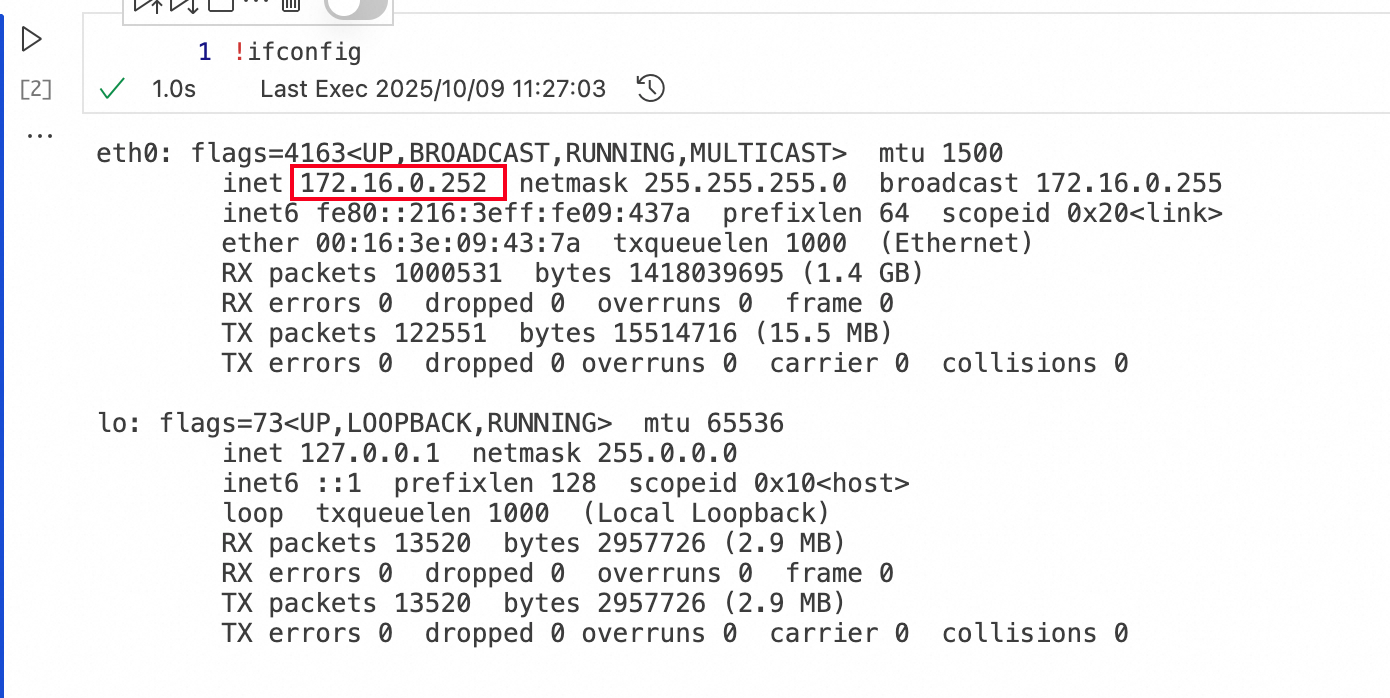
在Dify on DMS实例中访问服务
现在我们使用这份模拟销售数据文件来访问API服务:
• 在工作流中添加HTTP请求节点
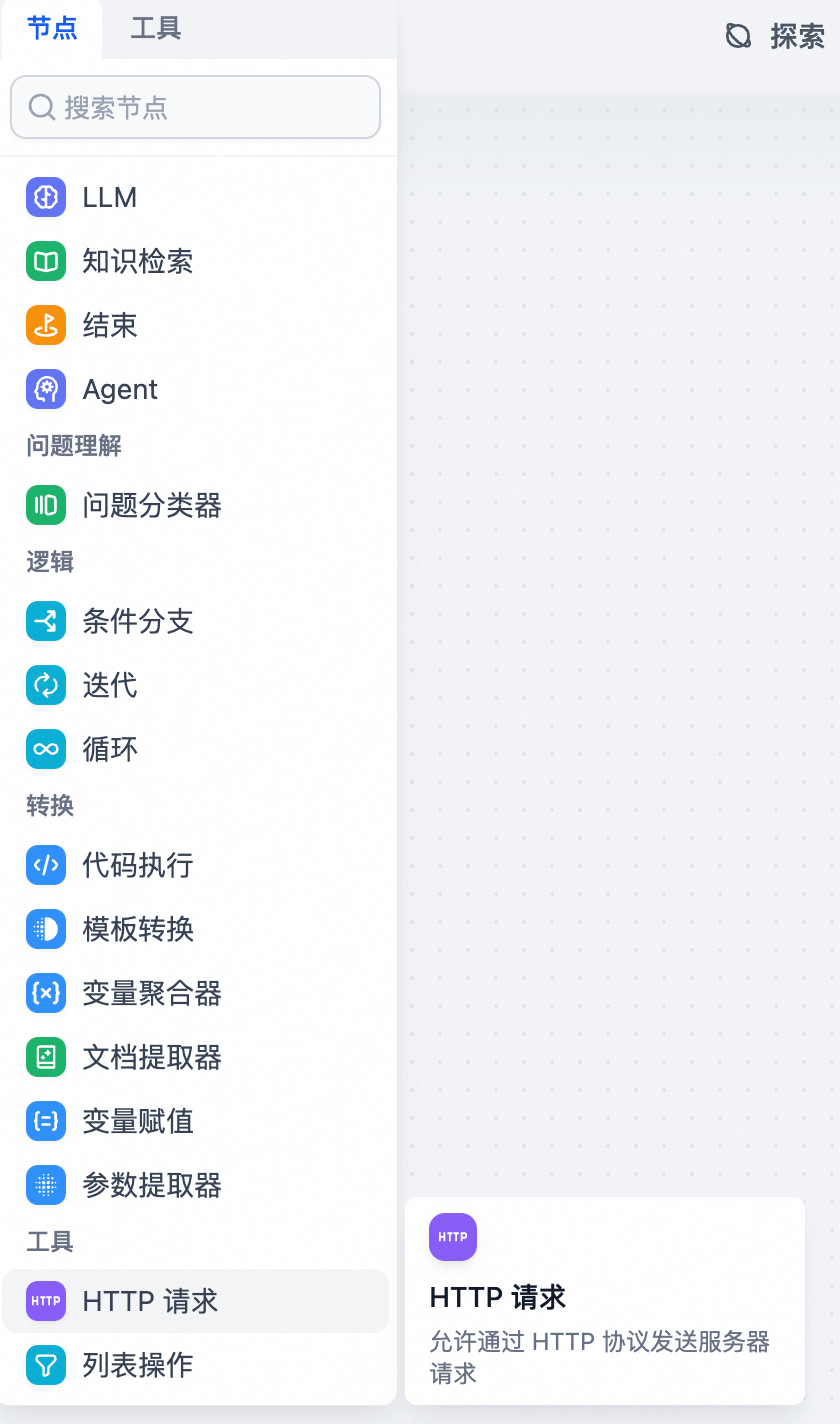
• 通过http://:<端口>/xxx 访问创建的API的服务,并在BODY中传入相应的参数
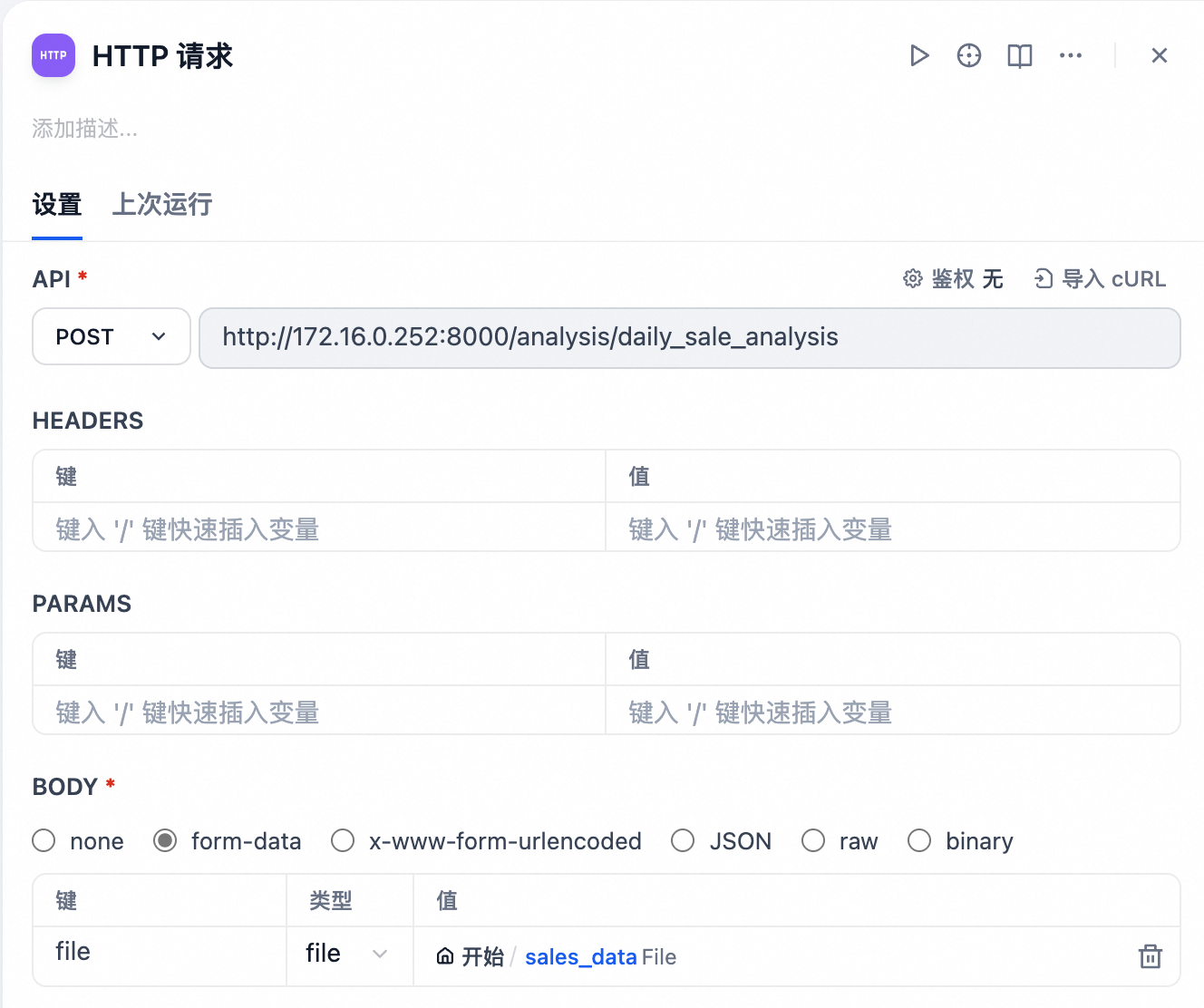
• 测试运行可以看到该请求成功返回了响应的输出
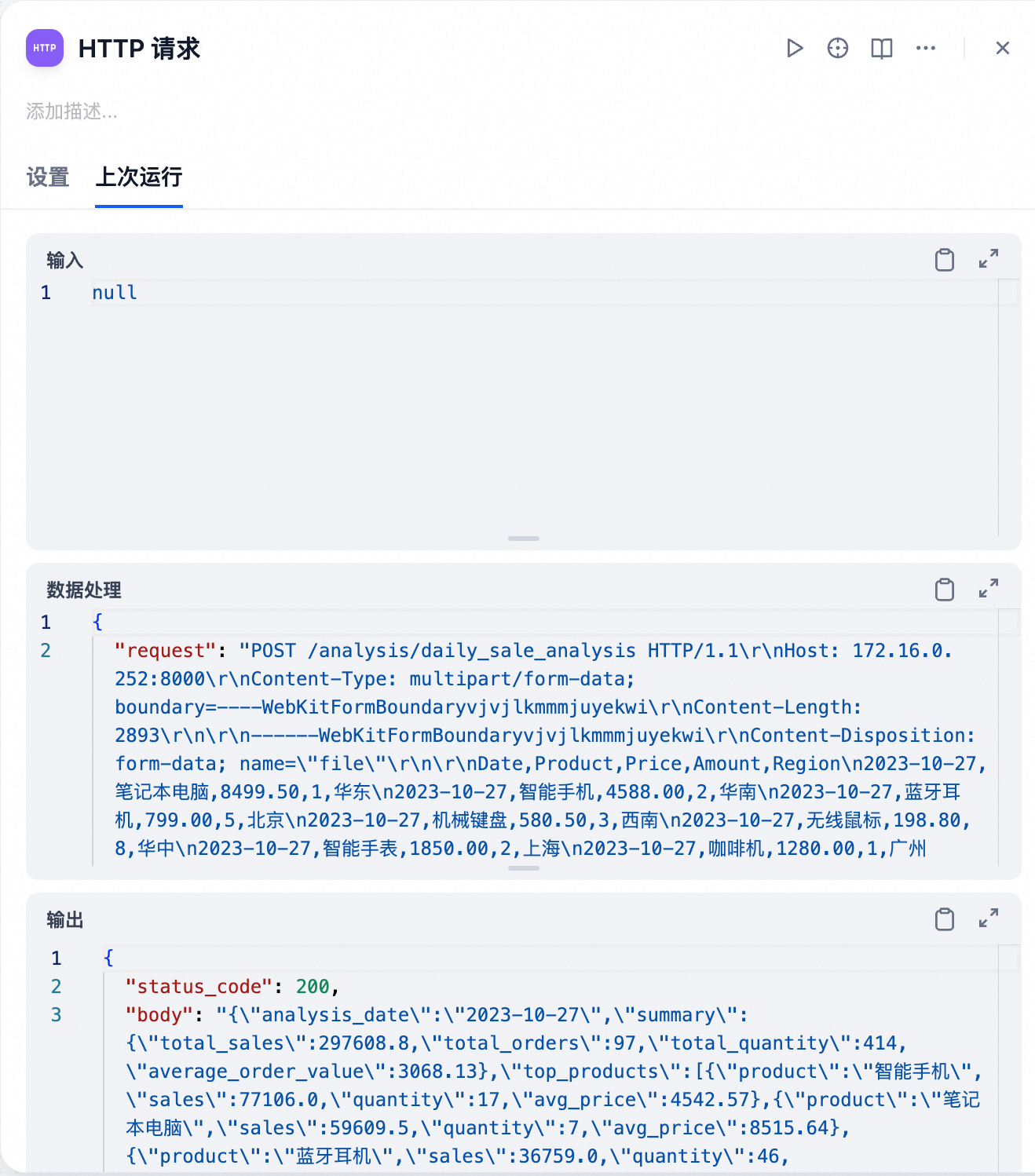
• 你也可以在Notebook会话中看到相应的服务被调用

接下来以该Dify工作流为例子进行完整的服务调用
销售数据分析.yml

在钉钉群组中添加一个自定义的机器人,并参考https://open.dingtalk.com/document/orgapp/robot-overview 了解如何获取钉钉机器人的access_token和sign_secret
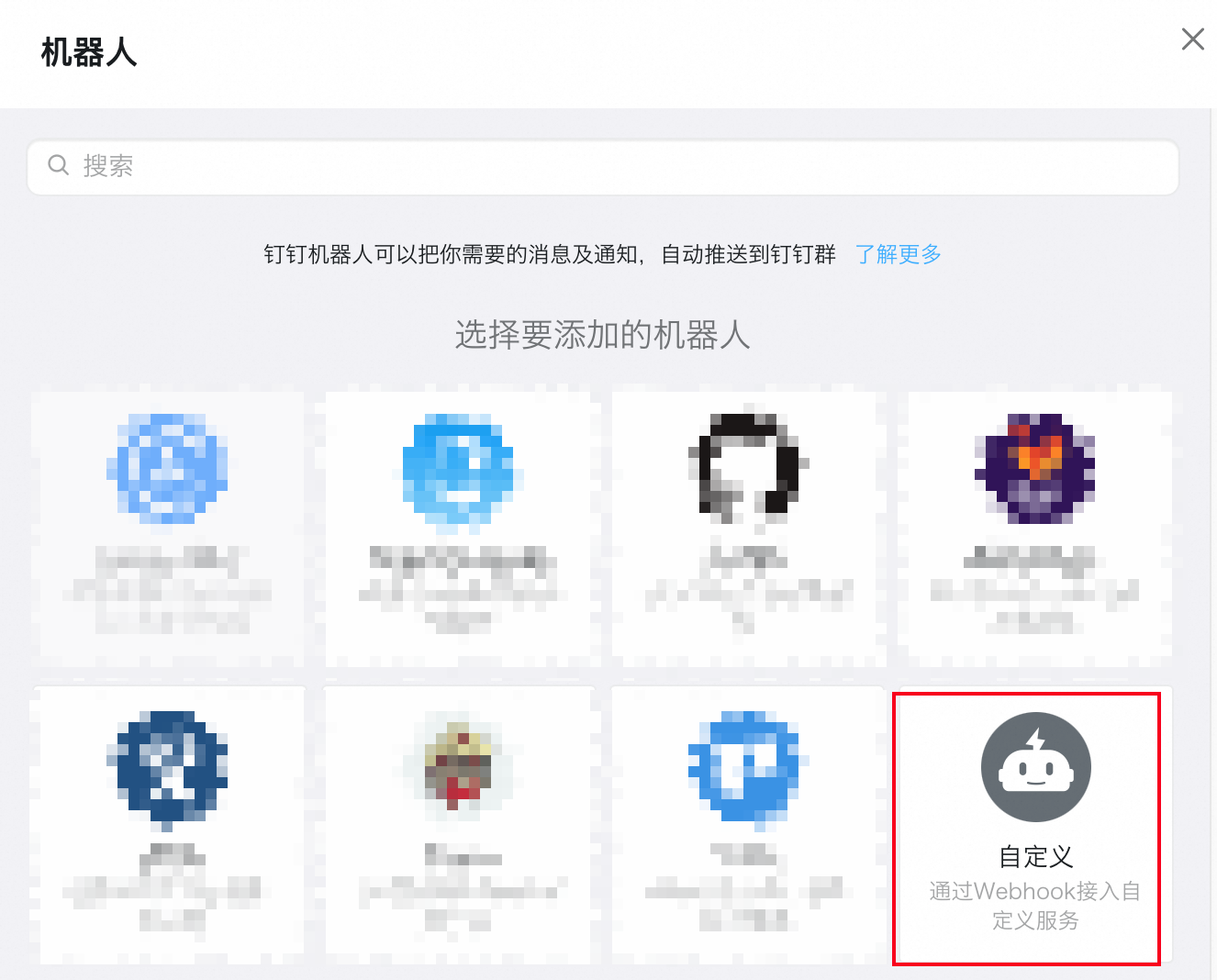
在填写完你的钉钉机器人参数之后,点击右上角的运行-》从本地上传上传示例的销售数据,并点击开始运行
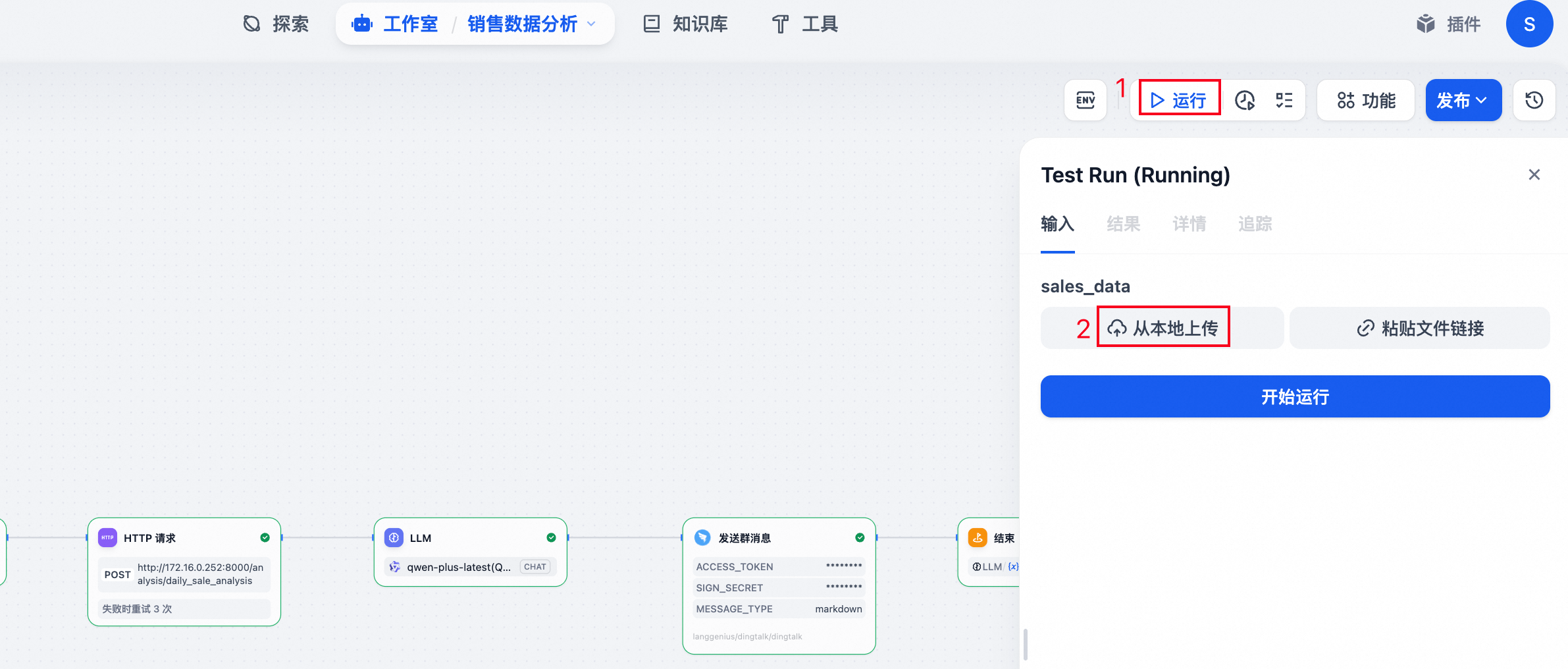
钉钉群中的机器人成功发送了对该销售数据的分析报告
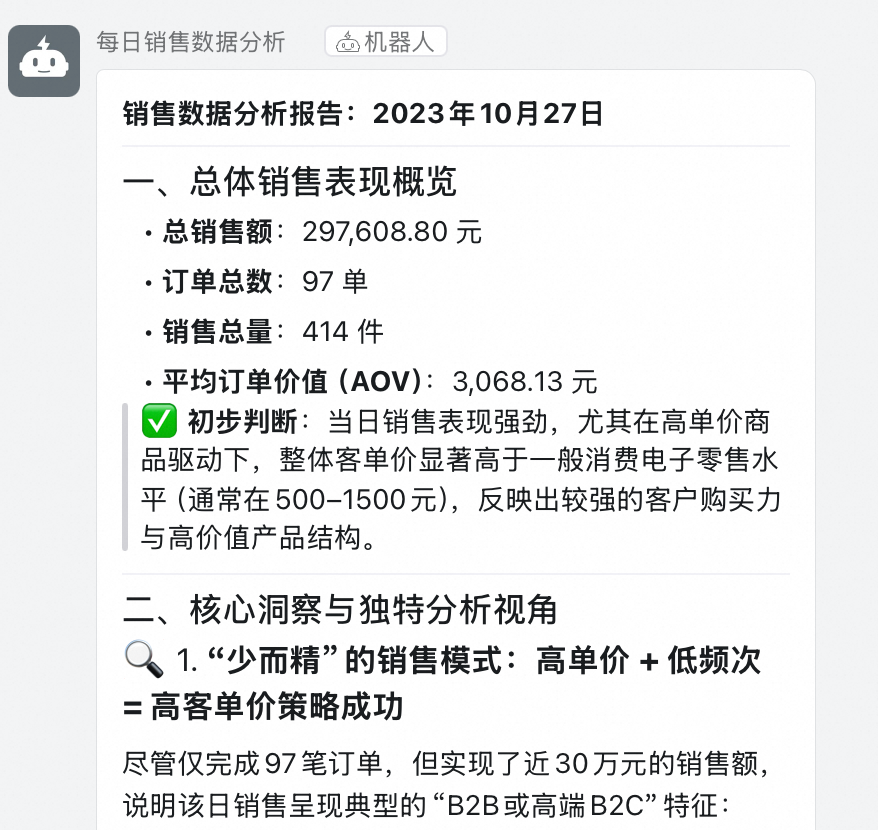
点击右上角的发布-》发布更新发布工作流用于后面的定时调用

使用 DMS Airflow 实现定时调度
创建DMS Airflow实例
参照以下链接在DMS中创建Airflow实例
https://help.aliyun.com/zh/dms/purchase-airflow-resources?spm=a2c4g.11186623.help-menu-26437.d_2_8_1_2_0.3aa88c02Z9PHKz: https://help.aliyun.com/zh/dms/purchase-airflow-resources?spm=a2c4g.11186623.help-menu-26437.d_2_8_1_2_0.3aa88c02Z9PHKz
https://help.aliyun.com/zh/dms/create-and-manage-an-airflow-instance?spm=a2c4g.11186623.help-menu-26437.d_2_8_1_2_1.1edc167ePCMXpI&scm=20140722.H_2881043._.OR_help-T_cn~zh-V_1:
更多关于Airflow的操作,参照https://airflow.apache.org/docs/apache-airflow/stable/index.html
编写 DAG:每日自动触发销售分析
• 以下是示例的python代码,用于定时调用Dify工作流的API
点击查看代码
import pendulum
import requests
import json
from airflow.models.dag import DAG
from airflow.operators.python import PythonOperator
from airflow.models import Variable
CSV_FILE_PATH = "/yourpath/daily_sale_data.csv"
DIFY_API_URL = "https://dify-dms.aliyuncs.com/v1" # 替换成你的 Dify Workflow API URL
# 从 Airflow Variable 中安全地获取 API Key
DIFY_API_KEY = Variable.get("dify_api_key")
APP_API_KEY= Variable.get("app_api_key")
def call_dify_workflow_with_csv(**kwargs):
"""
读取 CSV 文件内容,并将其作为文件上传调用 Dify 工作流。
"""
print(f"准备从 '{CSV_FILE_PATH}' 读取文件...")
try:
with open(CSV_FILE_PATH, 'rb') as f:
files_to_upload = {
'file': ('daily_sale_data.csv', f, 'document/csv')
}
# 准备 API 请求的 headers 和 body
headers = {
'Authorization': f'Bearer {APP_API_KEY}',
'DifyApiKey': f'{DIFY_API_KEY}',
}
file_upload_response=requests.post(
DIFY_API_URL+'/files/upload',
headers=headers,
data={'user': 'airflow-user-demo'},
files=files_to_upload,
)
print(file_upload_response.json())
file_id=file_upload_response.json().get('id')
headers.update({'Content-Type': 'application/json'})
# 'inputs' 通常是json字符串
# 'user' 是必须的,代表最终用户的标识符
input_data = {
'sales_data': {
"type": "document",
"transfer_method": "local_file",
"upload_file_id": file_id
}
}
data = {
'inputs': input_data,
'user': 'airflow-user-demo',
'response_mode': 'blocking',
}
print("开始调用 Dify API...")
print(f"URL: {DIFY_API_URL}")
response = requests.post(
DIFY_API_URL+'/workflows/run',
headers=headers,
json=data,
)
# 检查请求是否成功
response.raise_for_status()
print(f"API 调用成功!状态码: {response.status_code}")
# 打印响应内容
print("--- Dify API Response ---")
print(response.json()["data"]["outputs"]["answer"])
print("\n--- End of Response ---")
# 你也可以将完整的响应推送到 XComs,以便下游任务使用
# ti = kwargs['ti']
# ti.xcom_push(key='dify_response', value=full_response)
except FileNotFoundError:
print(f"错误:文件未找到于 '{CSV_FILE_PATH}'")
raise
except requests.exceptions.RequestException as e:
print(f"API 调用失败: {e}")
raise
with DAG(
dag_id="dify_workflow",
start_date=pendulum.datetime(2023, 10, 27, tz="Asia/Shanghai"),
# '0 8 * * *' 代表每天早上8:00 (UTC+8)
# Airflow 默认使用 UTC,但 Cron 表达式本身不带时区,调度器会根据 DAG 的时区设置来解释
schedule="0 8 * * *",
catchup=False,
tags=["dify", "api", "example"],
doc_md="""
### Dify 工作流调用 DAG
此 DAG 每天早上8点执行,它会:
1. 从本地文件系统读取一个 CSV 文件。
2. 将该 CSV 文件作为附件,调用一个 Dify 工作流。
3. 打印出 Dify API 的响应。
"""
) as dag:
run_dify_workflow = PythonOperator(
task_id="call_dify",
python_callable=call_dify_workflow_with_csv,
)
📌 注意:通过API调用Dify工作流中想要上传本地文件,需要先通过/files/upload接口传入相应的文件获取文件id,再将文件id传入工作流中。
• 创建完成后打开Airflow实例,可以看到创建的定时任务

• 每日 8:00,系统自动调用 Dify 工作流,最终由钉钉机器人推送分析报告
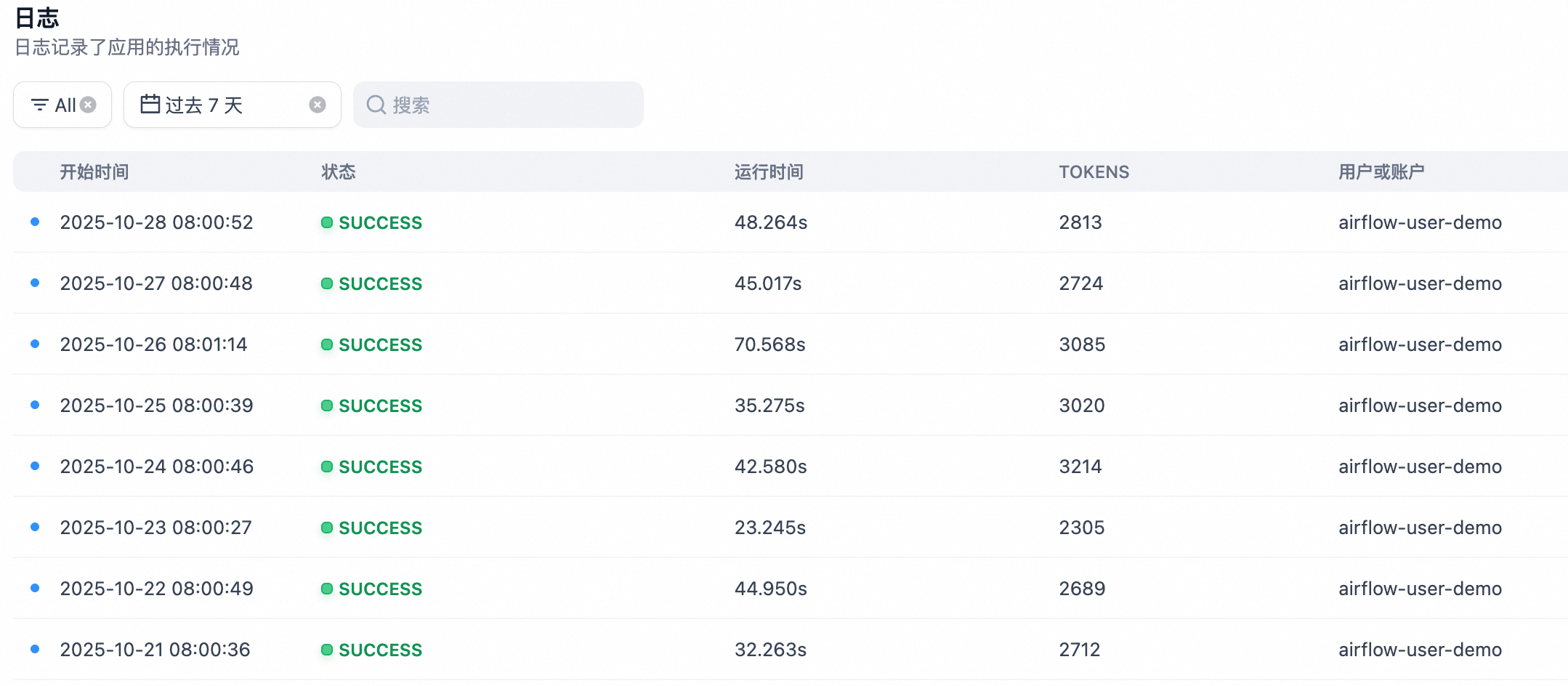
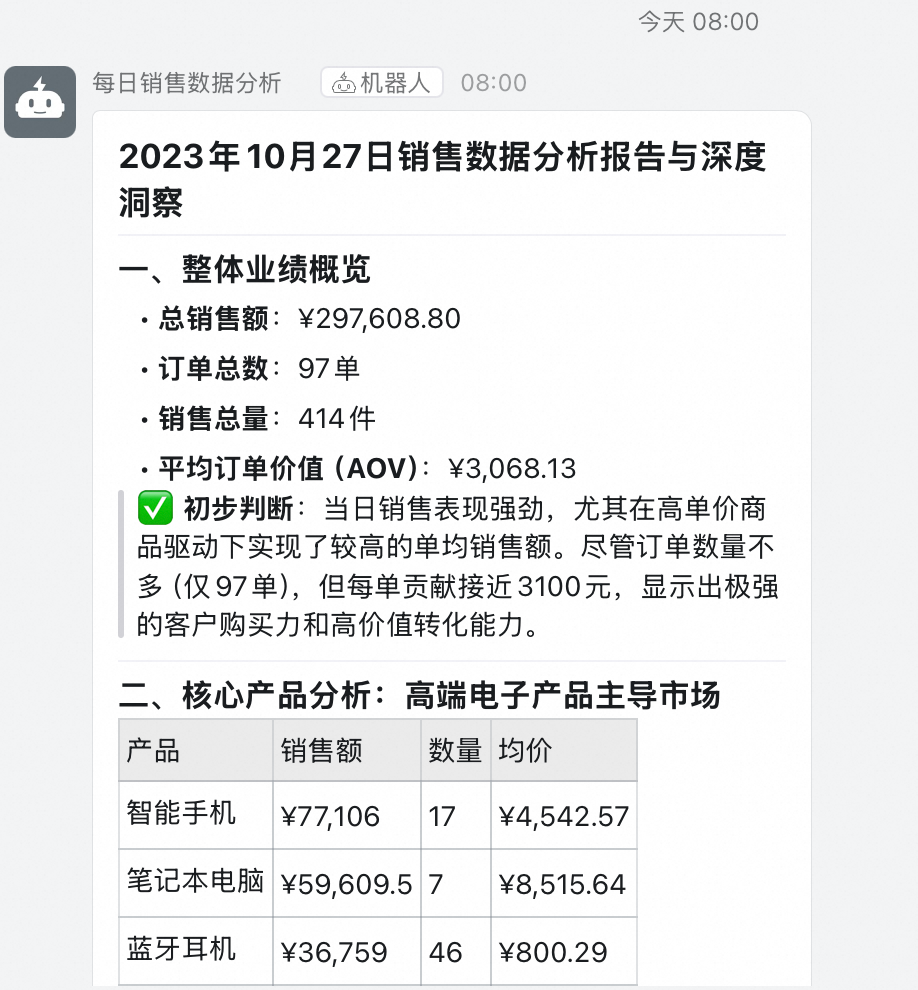
总结与思考
通过 DMS Notebook + DMS Airflow 对 Dify 的能力扩展,我们成功构建了一个具备以下特性的企业级 Agent 开发范式:

这套方案不仅解决了 Dify 当前的局限性,更重要的是,它保留了 Dify 的低代码优势,同时通过与成熟数据基础设施(Notebook + Airflow)的深度集成,实现了 “敏捷开发”与“工程可靠”的平衡。
🌟 核心理念:Agent 的价值不在于“全自动”,而在于“可扩展、可调度、可运维”。真正的生产级智能系统,一定是平台能力与工程实践的结合体。
了解更多
钉钉搜索:96015019923,加入Dify on DMS用户群!
Dify开通申请:https://page.aliyun.com/form/act1621739703/index.htm




 浙公网安备 33010602011771号
浙公网安备 33010602011771号